d.a.p.
On Curating
Interviews with Ten International Curators
Foreword by Hans Ulrich Obrist
Introduction by Carolee Thea
Mary Jane Jacob - Interview 2002 [online sample chapter]
Massimiliano Gioni - Interview 2007
RoseLee Goldberg - Interview 2006
Okwui Enwezor - Interview 2003
Charles Esche - Interview 2005
Carolyn Christov-Bakargiev - Interview 2005
Rirkrit Tiravanija - Interview 2007
Joseph Backstein - Interview 2005
PiLi - Interview 2006
Virginia Pérez-Ratton - Interview 2002
Contributors
Acknowledgements
Copyright Page
Copyright | Imprint
On Curating: Interviews with Ten International Curators
Copyright 2009 D.A.P./Distributed Art Publishers, Inc. Copyright 2009 by Carolee Thea. All images copyright the respective copyright holders.
All rights reserved. Neither this book nor any of the images contained therein may be reproduced in whole or in part, in any form, digital or otherwise, (beyond copying permitted by Sections 107 and 108 of the United States Copyright Law), without written permission first obtained from the copyright holders and from:
D.A.P./Distributed Art Publishers, Inc.
155 Sixth Avenue, 2nd Floor
New York, NY 10013
E-book Production: ARTBOOK | DIGITAL
This e-book is not intended to be a facsimile of the original print edition but rather a rendering of the original print edition in a digital manner that respects the textual and visual qualities of the original within the limitations of e-book file formats and readers at the time of its production: March 2011.
Published by:
ARTBOOK | DIGITAL
D.A.P./Distributed Art Publishers, Inc.
155 Sixth Avenue, 2nd Floor
New York, NY 10013
Tel: 212.627.1999
Fax: 212.627.9484
www.artbook.com
eISBN : 978-1-935-20254-7
Thea, Carolee.
"Editors: Carolee Thea and Thomas Micchelli."
1. Art museum curators–Interviews. I. Micchelli, Thomas. II. Title.
N408.T54 2009
708.0092'2—dc22
2009017924
"This book is a wonderful example of curatorial polyphony in the early twenty-first century.... The curators in this book have internalized the urgency to generate a situation receptive to complex spaces combining the big and the small, the old and the new, acceleration and deceleration, noise and silence. To change what is expected..."
--Hans Ulrich Obrist
BOOK: Pbk, 6.5 x 9.5 in., 144 pgs, 50 color. $29.95
ISBN 9781935202004![]()
add to cart with free shipping
EBOOK:Link to these online sellers:
Apple IBooks
NOOK Edition from Barnes & Noble
interview 2002
Mary Jane Jacob

Courtesy Mary Jane Jacob and John McWilliams, McClennanville, SC.
CT An issue engaging today's curators of biennials is the discovery and exhibition of artworks from emerging and diasporic communities. One could say that your concept of traveling art from one community to another (by train) in 1975 presaged the current inclusiveness of non-mainstream art at the same time it challenged assumptions about the audience for contemporary art. You could have easily followed a career in museums, working within established conventions. What were your personal motivations for doing this?
MJJ Mary Jane Jacob: I grew up in New York City, a place with great access to many museums and cultural events. When I traveled around the country, however, I found my experience wasn't the norm, and I became obsessed with how to bring rich encounters to other places and people. When I curated my first project, The Michigan Art Train, I was a graduate student interning for the Michigan Arts Council. Using a six-car train, we traveled the countryside stopping in one location per week. Here a community audience walked through the train, feeling a new spirit and acknowledging the value and accessibility of sharing the art. It was art for the public.

Courtesy the artist.
CT Hmmm, a way of having a temporary museum; it was an innovative strategy.
MJJ Mary Jane Jacob: Yes, it showed there were other ways of sharing and recognizing culture. One factor was to acknowledge what was already in place: not having to import art, but to look at the culture and resources of a specific locale. This was consistent with the hybrid activities of the time: facilitating new definitions of traditional forms that paralleled social and political upheavals.
It was a ripe moment for ushering in new audiences to participate in what had been considered an elitist experience. What people say about their places and values is often publicly submerged; the way I work allows for an easier evolution into the mainstream. Visiting the train, for example, gave the audience a moment to reflect—but not through eyes blurred by an esoteric dialectic. The idea was about perception—of our own lives as culture and history.
CT Your strategy included new audiences, and also gave equal respect to women and to regional artists.
MJJ Mary Jane Jacob: When I curate shows, it is to add value and insight to a place and to social issues. Monuments and ancient temples have always been with us, but newly heightened factors propelled public art into the locus of discussion: expanding in space and time outside the museum, as an exercise for artist and audience to connect in the present moment.
My interest in public art became official in 1990 when I left the museum in order to work in partnership with artists on projects conceived for certain locations—most significantly in 1991 for the Spoleto Festival in Charleston. It was here that I found an embracing discourse in public art: one that moved away from the monument/historical formula, or the contemporary masterpiece—like an Oldenburg or Calder—toward installations and process. It was art that brought dialogue through an incitement of memory.
CT Yes, it's about expanding the discourse of public art, not simply expanding genres. Going outside the museum, you have the possibility of encountering a more diverse audience interaction, and to look at and think about a place differently.
MJJ Mary Jane Jacob: A communal experience can also be a shared silence on a public street; it can propel a dialogue that extends beyond the art object. This is what public art can do—when you think about the public as much as the art.
CT Do you carry on your practice with institutional support?
MJJ Mary Jane Jacob: Yes, and it is directed toward programming—reshaping it with respect to the audience and the artist's work and making the institution as mutable as possible. A lecture or wall label may be among our tools, but my goal is to reunite a neighborhood through the living manifestation of an artist's ideas—ideas that would otherwise look solely symbolic, aesthetic or contrived.
I often return to a rudimentary definition of an artwork—as something that makes us see the world differently. The best dialogues I have are with people who don't have art degrees, those without preconceptions about art. They're open to my practice and will often say, “I don't know anything about art,” but then find themselves talking about art in ways that are very meaningful.
CT That fortunately turns received opinion on its head.
MJJ Mary Jane Jacob: Yes, we are often talking to ourselves or stratifying our experience as professionals—people with art degrees, with money—those from privileged social and economic circumstances.
My inspiration comes from Lewis Hyde's book Trickster Makes This World, where he speaks as a cultural critic, describing the mischievous trickster as one who articulates the living legends—and by greasing these memory joints of society, makes them flexible to the innuendos that history presents. For Hyde, and for me, the artist is a trickster, but the curator can play this role as well.

Courtesy Mary Jane Jacob and John McWilliams, McClennanville, SC.
CT Now that the Information Age has replaced the Industrial Age, many cities are left with deserted buildings occupying large, once economically forceful arenas. Where some cities have embraced their antiquated structures as alternatives to museums, others have built new signature edifices, such as the Guggenheim in Bilbao. Today, in the spirit of revitalization, touristic concerns are paramount, and I think it's safe to say that moving the Spoleto Festival to Charleston had a touristic charge.
MJJ Mary Jane Jacob: Yes. For one hundred years after the Civil War, Charleston lay fallow. It only began to come back after 1968. Then in 1977, Gian Carlo Menotti brought in the Spoleto Festival as a revitalization—to encourage tourism and other engagements.
But what we're doing with this visual arts program isn't only about tourism. We're benefiting from a strong cultural base that provides the latitude for art to act as an investigative tool.
CT Charleston is quite distinct in its economy, geography and special history as a famous seaport and slave market. Do you think that, with this dark history, it could serve as a model for other communities?
MJJ Mary Jane Jacob: Yes. There are lessons learned in these projects that can inform how we proceed in our work collectively. As a curatorial body, we're not just keepers of collections; we're inventing processes to bring about works, exhibitions and programs as a public art form. When I began working in Charleston for a show in 1991, it felt wildly expansive to be outside the museum, connecting to individuals in the community and creating projects made specifically for them. Frankly, I was not fully aware of what I had ventured into. When I was invited back in 2001, it seemed as if all I could do was duplicate the previous dialogue. However, at the opening of the second show, Evoking History, Part 1, many residents recounted in extraordinary detail how the works they had seen in my earlier show affected them.
CT Who were some of the artists in that first show?

Courtesy Mary Jane Jacob and John McWilliams, McClennanville, SC.
MJJ Mary Jane Jacob: The 1991 exhibition, Places with a Past: New Site-Specific Art in Charleston, dealt with those historic sites and included the artists Christian Boltanski, Chris Burden, Antony Gormley, Ann Hamilton, Elizabeth Newman, and David Hammons. There were twenty-three artists and eighteen installations, most placed in historic indoor or outdoor sites.
CT Was your work informed by other models, such as Sculpture Park in Munster in 1987?
MJJ Mary Jane Jacob: Indeed. I was particularly interested in the site-specific work by Rebecca Horn, which dealt with the forgotten histories of Munster, and as such attracted a wider local audience. The locals had a lived historical entry point, and they, not just the art historians, were the experts. History is our past and our present, and through art we recognize its vitality.
The public isn't scared away from this, and through it they encounter their own lives.
CT In the 90s, the demise of the National Endowment for the Arts in the United States was brought about by its innate philistinism. Today, however, the current tax structure enhances/encourages philanthropic funding of the arts and, it seems, has temporarily filled the void.
MJJ Mary Jane Jacob: We have studies and proof of the economic development-value brought by galleries, real estate, tourism and philanthropy, but that's not enough. Our root questions are: why does art matter and how does it have essential resonance and relevance?
CT Yes. It's an important dialogue.
MJJ Mary Jane Jacob: If we can't work across conventional social boundaries with our production and discussion of art, then we've been working in a restrictive way.
CT I'd like to compare your ideas with those of James E. Young, who examines the stages of memorialization as they have played out in design competitions in Berlin for Germany's national Holocaust memorial. Professor Young looks at how the vernacular of memorials has changed—how the very idea of the memorial has evolved from older, passive monuments in which memory is lost inside the material object. He based this on the observation that many monuments are less prompts for thinking about complex historical situations than expressions of a completed and sometimes one-dimensional interpretive process. While monuments do highlight historical connections, they can never replace public and individual responsibility for critical recollection and remembrance.
MJJ Mary Jane Jacob: Yes. Young's ideas are a reflection of major issues addressed in the contemporary debate on monuments, and thus of the quality of public historical awareness. One of the reasons public art has changed in the last thirty years was the need to expand beyond the traditional monument model where the patina has obscured relevance. Perhaps that kind of art doesn't speak to us anymore; maybe it never did. What's different about Charleston is how it has moved the discussion forward to embrace the city as a living memorial to slavery—and to the problematic economic relations that built this society.

Courtesy James Cohan Gallery, New York.
For six months, in weekly workshops in Charleston, the southern writer Neal Bogen worked with nine artists, architects, and poets discussing the nature of monuments, demographics and real estate relationships. This was a great influence for the artists assigned to the Festival's Memory of Water-Memory of Land project in 2002. Among these artists were J. Morgan Puett, Nari Ward and Yinka Shonibare.
CT Then, in your lexicon, it is clear that a memorial is an activity instead of an object.
MJJ Mary Jane Jacob: We're working with living monuments to commemorate ideas and actions that continue to be present. Barbara Kirschenblatt-Gimlet, one of our national stakeholders, made a distinction between the Lieu de Memoir and the Milieu de Memoir. The former being the man-on-a-horse type of thing, where a statue commemorates the event. The Milieu de Memoir, on the other hand, is a memory-prod to places where memory continues in the actions and consciousness of people in the present. Our mission is to deal with living memory as an important channel for change.

Courtesy the artist.
In 2000, Nigel Redden (the director at Spoleto) encouraged us to undertake an exhibition that would create a memorial to the Middle Passage. In his introduction, he said this could be hypothetical, temporary or impossible. His thinking was truly expansive and unconstricted—and frankly, none of us could imagine where it would end up.
We found that our preconceptions about monuments and symbolic memory were outmoded. New ones, which need to include living memory, should take another form. In this respect, this city has itself become a monument; neither to assuage the past nor to create something we pass on our way to somewhere else, but to create discussion.
END OF SAMPLE ONLINE CHAPTER
ONLINE SAMPLE CHAPTER
Mary Jane Jacob Interview 2002
from On Curating by Carolee Thea
CHAPTER IMAGES
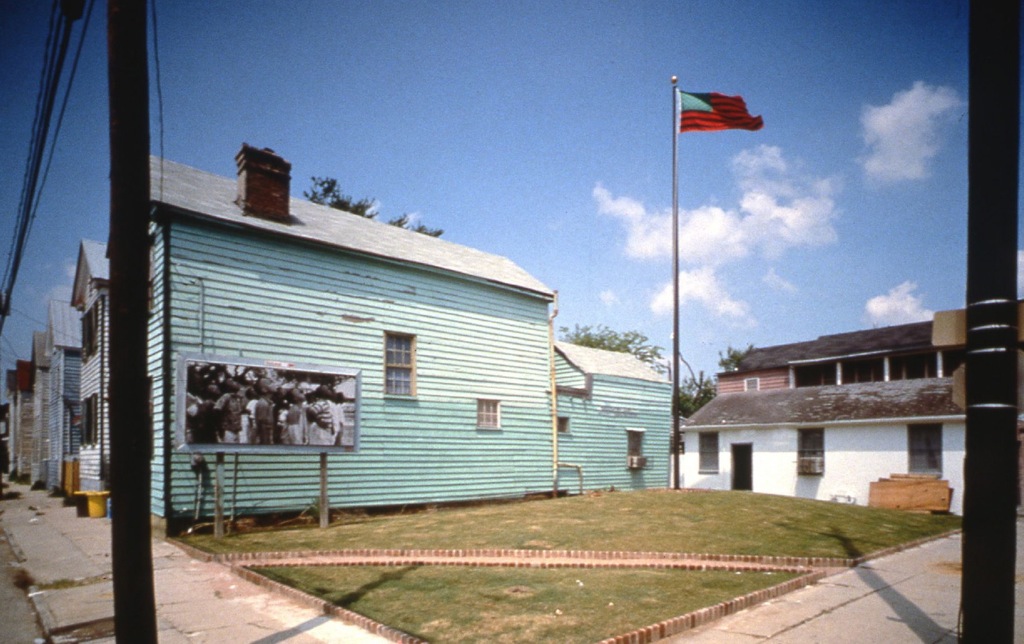
1. David Hammons, America Street, 1991.
Courtesy Mary Jane Jacob and John McWilliams, McClennanville, SC.
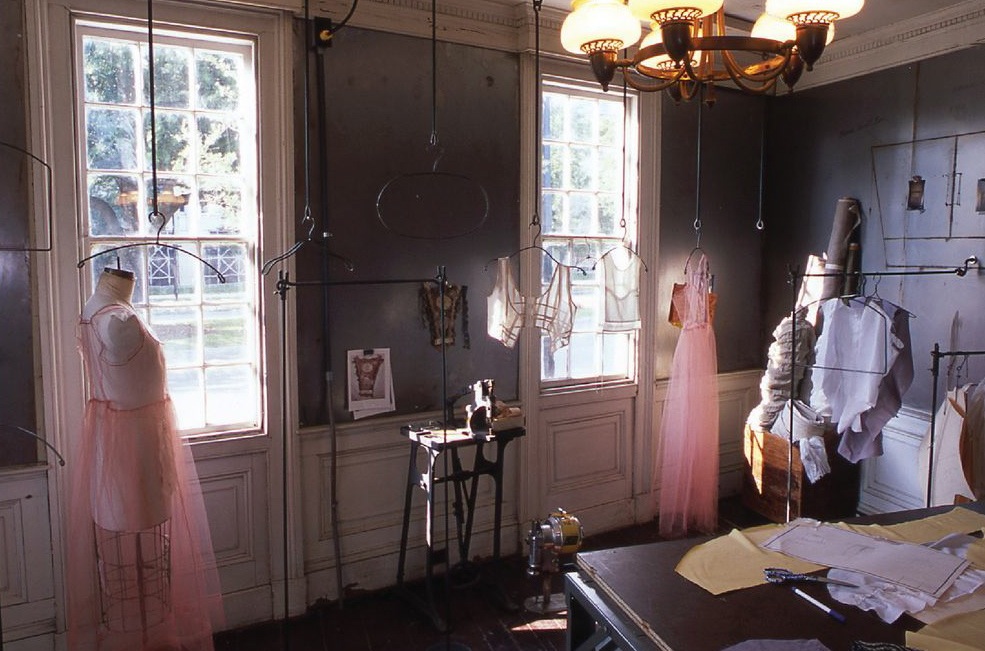
2. J. Morgan Puett, Cottage Industry: Thomas Carrol Cut Room and Shop, 2002.
Courtesy the artist.
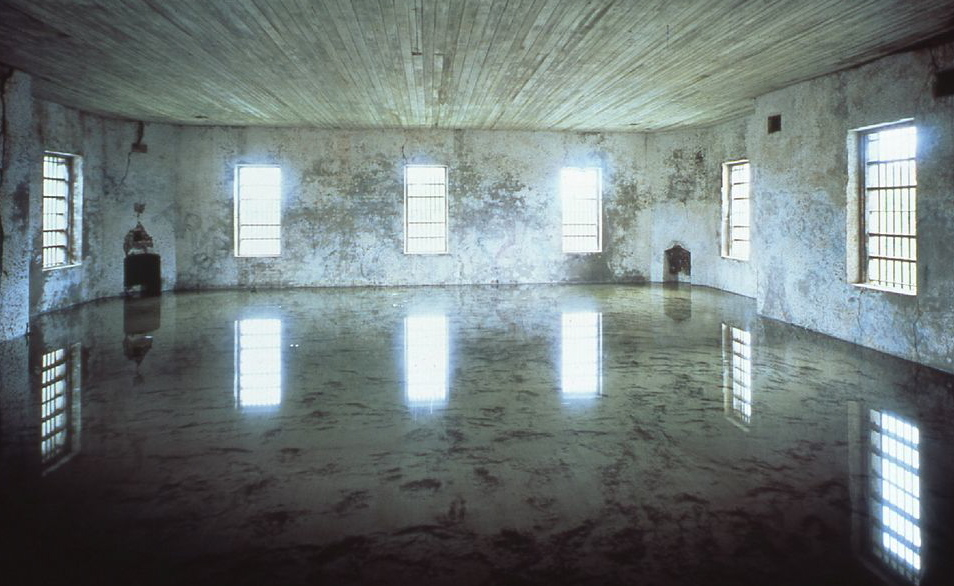
3. Antony Gormley, Sculpture for the Old City Jail, Charleston: Learning to Think, 1991.
Courtesy Mary Jane Jacob and John McWilliams, McClennanville, SC.
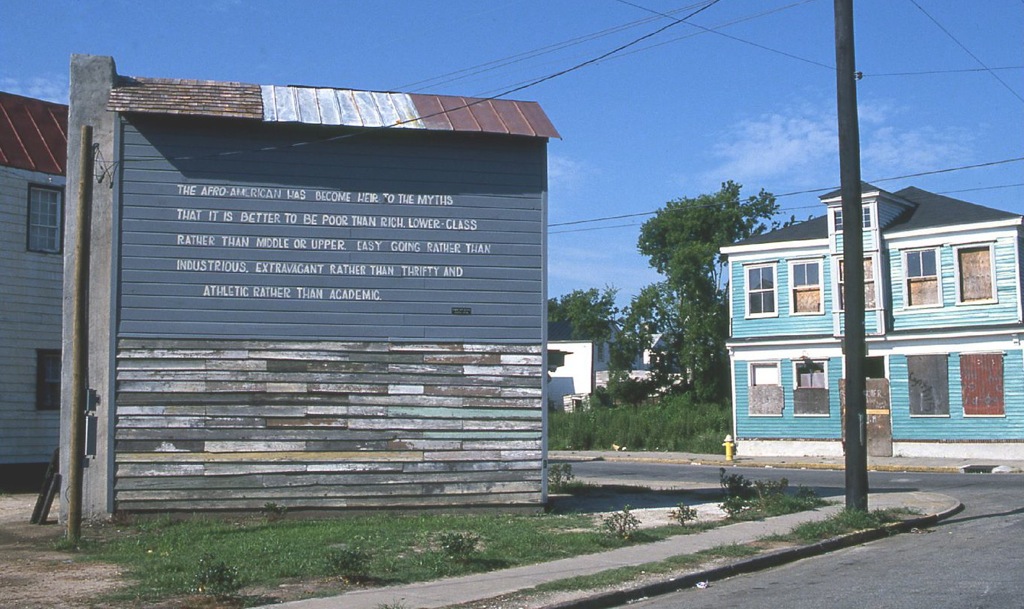
4. David Hammons, America Street, 1991.
Courtesy Mary Jane Jacob and John McWilliams, McClennanville, SC.

5. Nari Ward, Fortress, 2002.
Courtesy the artist.
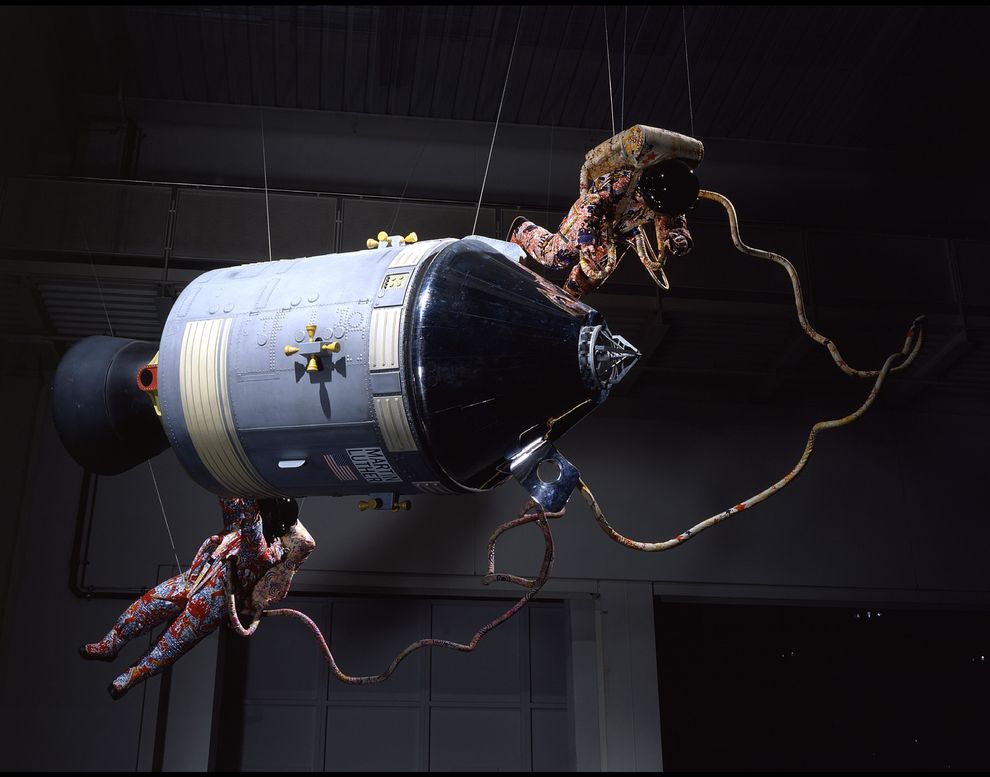
6. Yinka Shonibare, Spacewalk, 2002.
Courtesy James Cohan Gallery, New York.
